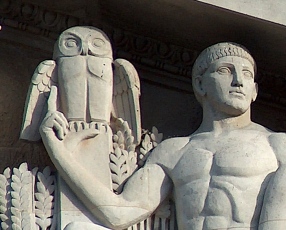
There are a fair number of statues of owls to be found around Britain in the form of architectural sculpture. In Classical antiquity, the owl was the bird of Athena, Goddess of wisdom, from which the idea of the wise owl would seem to emanate (though in 19th Century literature the phrase ‘as stupid as an owl’ is known, presumably referring to the bird’s difficulty finding its way around in bright daylight). The owl below left accompanying a figure of Athena is of this kind. The sculptor was G. A. Lawson. Another example, below right, is by the sculptor John Thomas, with the owl standing on a pillar next to the Athena figure, with below, a Classical bust. Both of these owls are in the typical standing position, wings pointing downwards, their front and lower edges slightly away from the body, and both are eared, as is the norm in owl sculpture.
The example below, presumably another statue of Athena, shows a variation on the theme, with a somewhat smooth owl sculpture, again standing, but with wings closer to the body; the thrust forward breast is characteristic of the bird, and is shown to advantage in this three-quarters view.
The owl does not need to be right next to Athena, as demonstrated by the portico below, which has a central Athena in keystone position, with to left and right, relatively large free-standing owl statues as summits to the pilasters. Very nicely carved, these ones, with particular emphasis to the feathers of the wings and legs, and around the eyes.
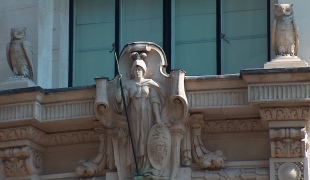 Athena with two free-standing owl statues.
Athena with two free-standing owl statues.
The owl is also the bird chosen by the city of Leeds for its coat of arms, which bears no less than three of them; two flanking a central shield which itself bears a sheep (indicating the fleece, recalling the woollen trade of the city) and a smaller owl on top. The example below left is typical; note that the owls are Royal ones with crowns. The short legs adapt rather well to holding the central shield. These are sculpted to be very downy on the breast and legs, another characteristic of many owl statues. Below right is another Leeds coat of arms. Here the owls, in high relief cut-out fashion, are heavily stylised, with the faces more like pairs of flowers, and the feet with grotesqued curly claws.
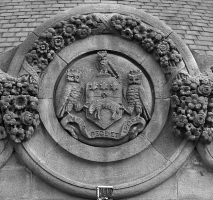
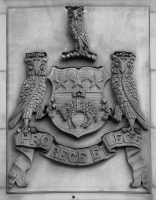 Leeds coat of arms, with three owls.
Leeds coat of arms, with three owls.
Owls are occasionally found on other coats of arms, as in this example, again with three of the birds sculpted in low relief. Small and rather stylised, these ones are shown in side view, and with particularly large ears for their size.
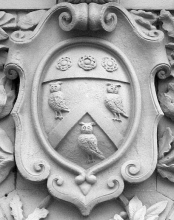 Low relief owls on a shield at arms.
Low relief owls on a shield at arms.
Here is a rather unusual owl statue, shown with wings outstretched. There seems little symbolism associated with this owl, unless it be the wisdom to guide the navigator of the ship shown in the roundel below.
We end with a couple of examples of owl sculpture from post-Edwardian times. The one at the top of this page is from the 1930s, with a reduction of the detail to give a characteristic smoothness; this owl has his wings half spread. And the whimsical high relief owl sculpture below is on the side of a 1960s building.
Visits to this page from 13 Mar 2014: 8,416
Eagle statues // Other animal sculpture // Allegorical sculpture